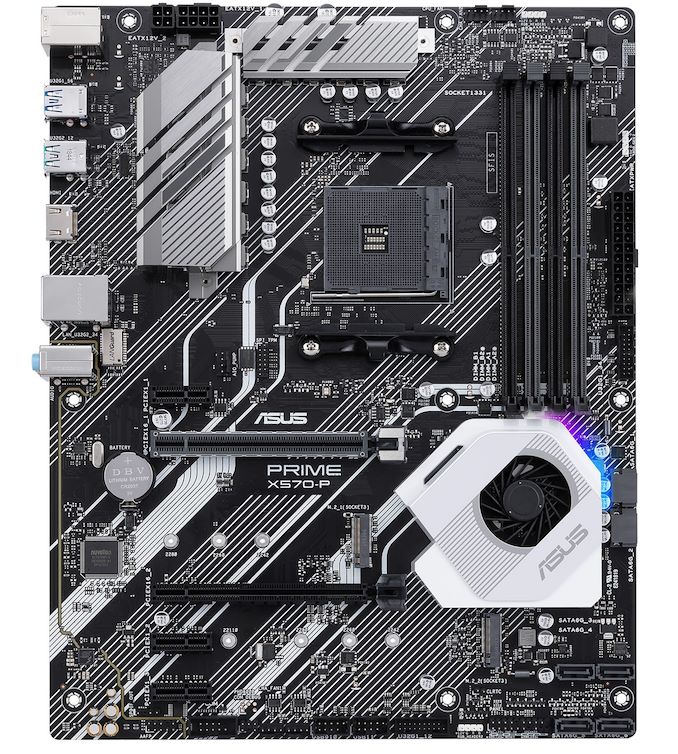The AMD X570 Motherboard Overview: Over 35+ Motherboards Analyzed
by Gavin Bonshor on July 9, 2019 8:00 AM ESTASUS Prime X570-P
Moving onto the second of the ASUS Prime series models, the ASUS Prime X570-P represents an entry-level offering to the X570 chipset with two full-length PCIe 4.0 slots, dual PCIe 4.0 M.2 slots, and a pair of budget-friendly Realtek controllers handling the onboard audio and networking. The most noticeable aspect of the board's design is how bare the PCB looks in contrast to other models from the ASUS X570 product stack.
The chipset heatsink is actively cooled with a white and silver design, while the PCB itself features a white and black design which is a trait of the Prime series itself. The Prime X570-P omits a rear panel cover entirely, and the chipset heatsink is running an 8-phase power delivery for the CPU VCore, with a seemingly adequate looking heatsink from our hands-on with this model at Computex.
On the main features, the ASUS Prime X570-P has two full-length PCIe 4.0 slots which operate at x16 and x16/x4. This is because the Ryzen 3000 series processors feed the top slot, while the bottom full-length slot lanes come directly from the X570 chipset. This means there is support for two-way AMD CrossFire multi-graphics card configurations, but none for NVIDIA SLI. For storage devices, there are two M.2 slots with support for PCIe 4.0 x4 drives, but users looking to run fast and hot running NVMe drives may need to purchase their own heatsinks as the board doesn't feature them; also included on the Prime X570-P are a total six SATA ports. Memory support is good with four memory slots with support for up to 128 GB with the 32 GB UDIMMs having been qualified by ASUS across its X570 product stack.
As expected with a more wallet-friendly model, the ASUS Prime X570-P rear panel isn't as bare as the lack of a rear panel cover would suggest with four USB 3.1 G2 Type-A, two USB 3.1 G2 Type-A, and two USB 2.0 ports. There are three 3.5 mm audio jacks which are controlled by a Realtek S1200A HD audio codec, a single Ethernet port controlled by a Realtek RTL8111H Gigabit NIC, a PS/2 combo port, and an HDMI video output for users of Ryzen APUs.
The ASUS Prime X570-P sits at the lower end of the X570 product and has an MSRP of $160. This model is designed to allow users a lower cost alternative to benefit from the X570 chipset features such as PCIe 4.0, and more native USB 3.1 G2 Type-A support; this model doesn't feature any Type-C connections, although, given the board's price, it's nothing out of the ordinary.












225 Comments
View All Comments
isthisavailable - Wednesday, July 10, 2019 - link
The industry needs to make up its mind when it comes to USB C. Laptops are launching with only USB C and meanwhile $700 motherboards only have 1 USB C port and 8+ "outdated" USB A'sThe_Assimilator - Wednesday, July 10, 2019 - link
It's almost like there's a huge amount of peripherals with USB-A connectors that people who use PCs expect to continue to work when they upgrade! Isn't backwards compatibility a funny feature?Meanwhile, the only peripherals that laptops generally use are docks, hubs, and storage devices - all of which have USB-C versions out the wazoo.
naris - Wednesday, July 10, 2019 - link
Why are memory speeds and channels show & discussed when talking about chipsets when the memory controllers are in the CPUs? Memory controllers have not been in chipsets for many years now!halfflat - Wednesday, July 10, 2019 - link
ECC support can be hard to verify for mere mortals; collating (or even better, verifiying) ECC capability on these motherboards would be an extremely useful addition to the article.ishkatar - Wednesday, July 10, 2019 - link
Does any of the boards support Raid 5? I only see 0, 1 and 10.Zibi - Wednesday, July 10, 2019 - link
You don't want to use RAID 5 without proper RAID Controller with cache.That means dedicated card.
Actually from performance / security perspective RAID 10 is pretty OK.
The_Assimilator - Wednesday, July 10, 2019 - link
AMD dropped RAID-5 support upon introduction of the AM4 socket (remember, chipset functionality like RAID is now a CPU function). I don't have an issue with that, since -5 is a very uncommon use-case in consumer workloads and if you want to do -5 right, you really want a hardware RAID card with a BBU.But -5 is pretty much dead anyway due to ever-increasing drive sizes - the rebuild time on anything over 1TB is horrendous, what you really want in such a scenario is RAID-6, and no consumer motherboard every has or will support that.
And please don't tell me you're using RAID-5 for data integrity, because invisible corruption is a thing that I have experienced personally. If you want *actual* data integrity, use Windows Storage Spaces or RAID-10, and as a last resort RAID-6.
Arbie - Wednesday, July 10, 2019 - link
There must be something you left out of this roundup. Whatever it was, please go back and put it in, and next time get it right. Thanks.Korguz - Wednesday, July 10, 2019 - link
huh ????Gastec - Wednesday, July 10, 2019 - link
That $700 must be an error right, perhaps of judgement?